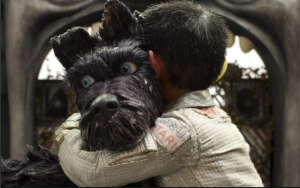Metro In Focus: Wes Anderson’s Isle of Dogs a labour of love and patience.
 By Richard Crouse – Metro In Focus
By Richard Crouse – Metro In Focus
Imagine the painstaking process that goes into making stop-motion animated films like Isle of Dogs. Instead of using computer-generated imagery, animators meticulously manipulate little puppets a centimetre or two at a time, shoot a frame or two and repeat the process until the film is done. On average, working at a good clip, a stop-motion animator can complete one or two minutes of film per week.
According to whom you speak, the process is either a labour of love or pure torture.
“People think it’s monotonous and tedious, but I think stop motion creates a dream quality,” said legendary animator Ray Harryhausen. “I never found it tedious or monotonous.”
Others, like The Boxtrolls producer Travis Knight, say “It’s the worst way to make a movie. It makes no sense.”
However you feel about the method, the results are beautiful. At its best, stop motion has a timeless quality and otherworldly charm born from the old-fashioned process that brings it to the screen. It’s handmade with a level of craftsmanship and soul that not even the most skilled programmer working on an advanced computer can imitate.
“There’s a strange quality in stop-motion photography, like in King Kong,” says Harryhausen, “that adds to the fantasy. If you make things too real, sometimes you bring it down to the mundane. In Kong, you knew he wasn’t real, but he looked like a nightmare, you know? He acted real, and the dinosaurs looked real. But there was something about them that had a magic that you don’t quite get yet in CGI.”
Director Wes Anderson says Harryhausen’s work and the stop-motion animated holiday specials of Rankin/Bass Productions inspired Isle of Dogs.
“I really liked these TV Christmas specials in America,” he said. “I always liked the creatures in the Harryhausen-type films, but really these American Christmas specials were probably the thing that really made me want to do it.”
A film still from Isle of Dogs Behind the Scenes (in virtual reality) by Paul Raphael, Felix Lajeunesse and the Isle of Dogs Production Team.
Isle of Dogs, which became the first animated film to ever open the Berlin Film Festival in February, tells the story of the exile of the dogs of Megasaki City to a vast garbage dump, and a 12-year-old boy who sets off to find his lost pet.
The film’s handmade technique is already earning rave reviews. Slate said that Anderson’s stop-motion animations, including 2009’s Fantastic Mr. Fox, “are the warmest, the most emotionally accessible, the most real” of all of Anderson’s films.
That’s the magic of stop motion. From its earliest usage in 1897’s The Humpty Dumpty Circus, to the pioneering work of Harryhausen and Willis O’Brien, to the advanced visions of Aardman’s Wallace and Gromit movies, the exquisite Coraline from Henry Selick, and Czech filmmaker Jan Švankmajer, who mixes stop motion with live actors, all stop-motion films have one thing in common — a humanity that shines through the technology. It isn’t perfect, it’s primal.
Animation, as Pixar’s Brad Bird says, is about creating the illusion of life. Stop motion, with its reliance on the animator’s hands-on skills, presents an imperfect but organic image that can ignite imaginations.
Harryhausen told me it was the stop motion of the original 1933 King Kong that changed his life. “I saw it when I was 13,” he said, “and I haven’t been the same since.”
